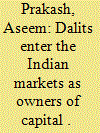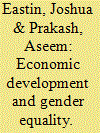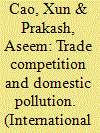|
|
|
Sort Order |
|
|
|
Items / Page
|
|
|
|
|
|
|
| Srl | Item |
| 1 |
ID:
142604


|
|
|
|
|
| Summary/Abstract |
Dalits find themselves included in India’s markets at adverse terms, due to the lack of social networks based on caste locations. This paper argues for considering caste as a specific Indian form of civil society—as a site of accumulation.
|
|
|
|
|
|
|
|
|
|
|
|
|
|
|
|
| 2 |
ID:
175927


|
|
|
|
|
| Summary/Abstract |
A key obstacle to nuclear energy as a decarbonization policy is the public perception of risks of radiation leaks from reactors. In particular, the “not-in-my-backyard (NIMBY)" syndrome suggests that individuals oppose nuclear reactors in their neighborhoods because they overestimate their risks. Arguably, such perceptions would be acute for those who have lived in the vicinity of a nuclear accident. We conducted a surveyembedded experiment in Japan (N = 2574) to assess how the NIMBY syndrome influences public support for restarting nuclear reactors when health, economic, and climate change benefits of nuclear energy are highlighted. We focus on Japan because the risks of nuclear energy became salient after the 2011 Fukushima accident. We test for two types of NIMBY effect, (1) respondents' proximity to any nuclear power plant and (2) respondents' place of residence in 2011 and its proximity to Fukushima. We do not find support for either the NIMBY syndrome or the Fukushima effect. On the contrary, we find support for a “reverse-NIMBY” among low-income residents, when they are treated with information on nuclear energy's low local air pollution (health). Our findings suggest that support for nuclear energy varies across population groups and depends on how its local benefits and costs are framed.
|
|
|
|
|
|
|
|
|
|
|
|
|
|
|
|
| 3 |
ID:
119689


|
|
|
|
|
| Publication |
2013.
|
| Summary/Abstract |
This research note examines the relationship between economic development and gender equality. Drawing on the concept of the Kuznets curve, the authors hypothesize that the relationship between economic development and gender inequality is curvilinear (S shaped), with three distinct stages. In the first stage, economic development improves gender equality because it enables greater female labor-force participation. An independent income stream increases women's intrahousehold bargaining power. The opportunity to develop human capital confers greater political and social recognition. In the second stage, labor-force stratification and gender discrimination encourage divergent male/female income trajectories, which decrease the opportunity costs of female labor-force withdrawal and lend traction to social resistance against burgeoning gender norms. Consequently, there is a deceleration in initial equality gains. In the final stage, gender equality again improves, as greater educational participation and technological advancement provide new employment opportunities for women, increase the opportunity costs of staying home, and encourage the evolution of new social institutions and norms that overcome prior discriminatory practices. The authors find support for this argument in statistical tests of the relationship between economic development and gender equality on a panel of 146 developing countries for the period 1980-2005. They employ four indicators that reflect distinct dimensions of women's political, social, and economic status. They find economic development positively influences gender equality when per capita incomes are below $8,000-$10,000. These equality gains level off or decline slightly in the second stage, from $8,000-10,000 to about $25,000-$30,000. Beyond this level, economic development is again associated with improvements in gender equality. The key implication is that the effect of economic development on gender equality is contingent on the level of development. Policymakers and social activists should develop policy correctives to ensure that economic development confers improvements in gender equality across phases of development.
|
|
|
|
|
|
|
|
|
|
|
|
|
|
|
|
| 4 |
ID:
047630


|
|
|
|
|
| Publication |
London, Routledge, 1999.
|
| Description |
xiii, 338p.
|
| Standard Number |
0415242495
|
|
|
|
|
|
|
|
|
|
|
|
Copies: C:1/I:0,R:0,Q:0
Circulation
| Accession# | Call# | Current Location | Status | Policy | Location |
| 043576 | 337/PRA 043576 | Main | On Shelf | General | |
|
|
|
|
| 5 |
ID:
078844


|
|
|
|
|
| Publication |
2007.
|
| Summary/Abstract |
Competition to attract foreign direct investment (FDI) creates opportunities for multinational enterprises (MNEs) to diffuse corporate management practices from their countries-of-origin (home countries) to countries hosting their foreign operations. We examine conditions under which MNEs transfer corporate environmental practices from home countries to host countries. Our focus is on ISO 14001, the most widely adopted voluntary environmental program in the world. We examine inward FDI stocks and ISO 14001 adoption levels for a panel of 98 countries, and a subset of 74 developing countries, for the period 1996-2002. We find support for the country-of-origin argument in that inward FDI stocks are associated with higher levels of ISO 14001 adoption in host countries only when FDI originates from home countries that themselves have high levels of ISO 14001 adoption. Countries' ISO adoption levels are associated not with how much FDI host countries receive overall but from whom they receive it. Three implications emerge from this study: (1) FDI can become an instrument to perpetuate divergence in corporate practices across the world; (2) economic integration via FDI can create incentives for firms to ratchet up their environmental practices beyond the legal requirements of their host countries; (3) instead of racing down to match the less stringent corporate practices prevalent in developing countries, developed countries can employ FDI outflows to ratchet up corporate practices abroad given that developing countries are net recipients of developed countries' FDI outflows.
|
|
|
|
|
|
|
|
|
|
|
|
|
|
|
|
| 6 |
ID:
136613


|
|
|
|
|
| Summary/Abstract |
How might domestic regulatory institutions influence the adoption of global private regimes? We focus on the ISO 9001 and 14001 certification standards, which obligate firms to establish quality and environmental management systems. Previous research highlights the roles of international commercial audiences and national regulatory pressures as unconditional drivers of adoption. However, we argue that domestic regulatory institutions condition their effects—in opposite directions. Where regulatory institutions function well, firms facing high levels of regulatory pressure are more likely to seek ISO certification, but firms facing pressures from international audiences are less likely to do so. In contrast, weak regulatory institutions make export-oriented and foreign-owned firms more likely to seek ISO certification, but render firms facing high levels of regulatory pressure less likely to do so. We find support for our claims using firm-level data from 10,000 firms in 30 countries in Eastern Europe and Central Asia.
|
|
|
|
|
|
|
|
|
|
|
|
|
|
|
|
| 7 |
ID:
097722


|
|
|
|
|
| Publication |
2010.
|
| Summary/Abstract |
This research note examines whether trade competition abets regulatory races in the environmental area. To analyze trade competition, we develop a new measure, structural equivalence, which assesses competitive threats that a country faces from other countries whose firms export the same products to the same destination countries. Employing this new measure, we analyze air pollution intensity (sulfur dioxide or SO2) and water pollution intensity (biochemical oxygen demand or BOD) for a panel of 140 countries for the time period 1980-2003. We find that trade competition is a significant predictor of water pollution intensity among structurally equivalent countries. We then test separately whether trade competition abets upward and downward regulatory races. We find that in the case of water pollution, countries respond symmetrically to downward and upward races, that is, they follow their structurally equivalent competitor countries both when they ratchet down their regulations and when they ratchet up regulations. In the case of air pollution, however, countries are responsive to downward policy changes only in competitor countries.
|
|
|
|
|
|
|
|
|
|
|
|
|
|
|
|
| 8 |
ID:
093226


|
|
|
|
|
| Publication |
2009.
|
| Summary/Abstract |
This article investigates the nature of the linkages between trade and labor rights in developing countries. Specifically, we hypothesize that a "California effect" serves to transmit superior labor standards from importing to exporting countries, in a manner similar to the transmission of environmental standards. We maintain that, all else being equal, the labor standards of a given country are influenced not by its overall level of trade openness, but by the labor standards of its trading partners. We evaluate our hypothesis using a panel of 90 developing countries over the period 1986-2002, and we separately examine the extent to which the labor laws and the actual labor practices of the countries are influenced by those of their export destinations. We find that strong legal protections of collective labor rights in a country's export destinations are associated with more stringent labor laws in the exporting country. This California effect finding is, however, weaker in the context of labor rights practices, highlighting the importance of distinguishing between formal legislation and actual implementation of labor rights.
|
|
|
|
|
|
|
|
|
|
|
|
|
|
|
|
| 9 |
ID:
050911


|
|
|
|
|
|
|
|